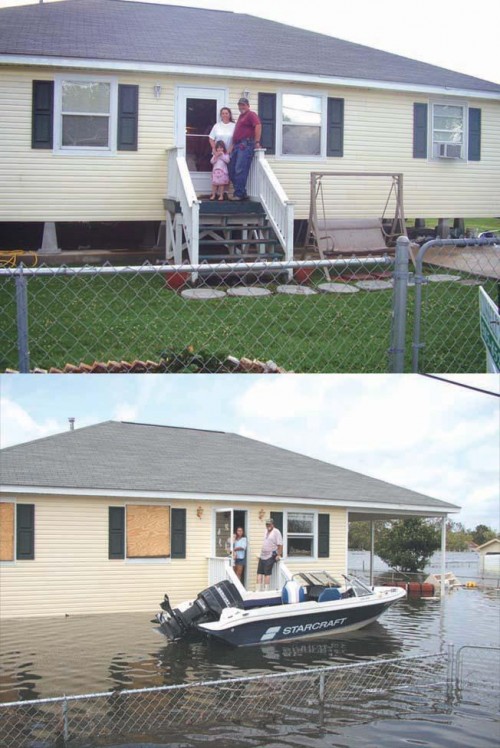William Hetzer, Sr.
June 1, 2007
Gerald Hite, Sr.
June 8, 2007It’s been two years since the fateful 2005 hurricane season took many by surprise. This time, local and parish governments are determined to be ready if a big storm comes again.
Perhaps the most obvious example of these changes comes in southern Terrebonne Parish, where nearly 10,000 homes flooded from Hurricane Rita’s storm surge. New building codes and elevation requirements are in affect and the Terrebonne Parish Department of Planning and Zoning is the group overseeing the changes.
“We’ll be praying that we don’t get hit with a large hurricane, that’s for sure. But, we need to prepare for the worst, there’s no doubt. And to prepare for storms like this you need to start preparation early, and the earlier the better,” said the Planning and Zoning Department’s director, Patrick Gordon.
New structures, like residential homes, are being built to withstand 130 to 140 mph winds and being elevated a foot higher than previous flood maps, according to Gordon.
“There’s a big difference between what took place a couple of years ago and now in preparation for storms. The structures are built to a higher quality, to withstand higher winds and are also being elevated higher to withstand higher flooding type situations,” said Gordon. “We’re much better off for the new construction.”
The old structures still remain a problem, however. Gordon said he wishes the owners of structures that repetitively flooded would elevate them, and claims Road Home or Increase Cost of Compliance money can be used to help pay for the elevation.
Owners can receive up to $30,000 of ICC money through FEMA if they are required to raise their house during repairs paid for by their flood insurance. The Road Home program is also offering $30,000 to such property owners.
“It’s enough money to elevate homes that are on piers or blocks. To elevate a structure on a slab would cost considerably more,” said Gordon.
Despite the availability of funds to elevate home, some property owners are claiming that receiving the money can be an issue. Many Hurricane Rita victims that have signed up for FEMA funds through the Road Home program have yet to receive the money. There homes remain at risk for another storm surge.
Sheryl Falgout, an 18-year homeowner in Chauvin, said he signed up for the Road Home program last February in an effort to get money to raise his flood damaged home from its currently four feet elevation to eight feet. He says he has yet to hear back from the agency.
“If they give me the money to raise it, then I’m going to raise it up,” he said.
Falgout claims to know more people in the Chauvin area who signed up with FEMA over a year ago and are still waiting.
Rita flooded Falgout’s Rosemary Street home, and he’s still in the process of repairing the damage, after being slowed down by a heart attack. He admits the house isn’t built to current building codes and must be elevated at least another foot the meet FEMA standards. But he says his neighbors are in the same situation, and many of them have been elevating their homes as much as 10 feet.
Gordon said there is another funding option, Flood House Grants, which are available through the parish. Terrebonne has applied for two such grants for hurricanes Katrina and Rita. The director expects $5.1 million in the near future to help elevate some of the substantially damaged structures.
The parish has completed about 35 elevation projects thus far n 11 of which were slab raises n and Gordon is encouraged by how many owners have spent their own money to elevate their homes.
He gave an off-the-cuff number for the amount of old structures that have been raised since Rita. He put the rough estimate at 300 to 400 structures that are now elevated to meet the new post-Rita standards.
“We need to continue this trend in the low-lying areas, and have all the structures elevated to the base flood elevation,” he said.
But while the new elevated structures are built to resist strong winds. Gordon admits older structures won’t be as resilient. He said Terrebonne Parish has been fortunate enough not have experience the major winds of a category three or higher hurricane.
“I think there’s always that storm out there that we may get hit with, with high winds. And if those structures are elevated and not built to the new building codes, it would certainly pose a higher risk than those structures that were built to the current codes,” said Gordon.
As for Falgout, he understands the risk but feels helpless to do anything about it.
“Ain’t nothing much I can do, but wait and just hope we don’t get no more [storms],” he said.
Photos by Pamela Guidry • Tri-Parish Times • Paul Whitney and his family were among the many residents of Chauvin that experienced the flooding of Hurricane Rita. The family has since renovated their Rosemary Street home.










